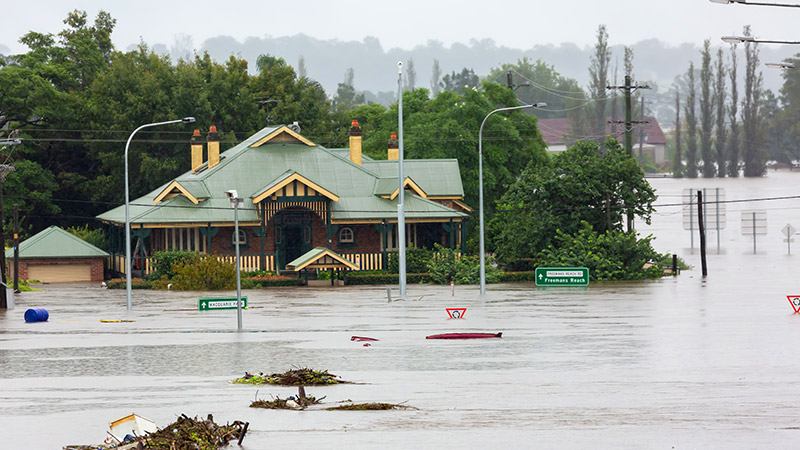Pandemic, flood anniversaries reveal stark differences in property market impacts
Two devastating disasters, two very different outcomes for the nation's property markets; on the third anniversary of the onset of Covid and one year after floods ravaged eastern Australia, we look at the impact each massive upheaval had on real estate markets around the nation.
Australia this week marks the anniversaries of two massive events that shook the social and economic fabric of the country, one of which rattled the nation’s economic foundations and another that sank the hopes and dreams of thousands.
Three years ago the World Health Organisation declared a global pandemic, while a year ago Australia’s most costly natural disaster ever unfolded as the east coast was inundated with torrential rains that caused flooding that displaced thousands.
While the devastating impact that the extreme weather events and climate change had on people and property cannot be understated, the impacts of the Covid pandemic on property markets is more complex and varied.
Insurance Council of Australia’s CEO, Andrew Hall, said the damage to property and possessions caused by the east coast flooding cost $5.7 billion.
“Insurers are assisting their customers by finalising assessments, repairs and rebuilds and completing claims, with 78 percent of the more than 239,000 claims now closed,” he said.
Floods turn boom to bust
Before the weather rained on its parade, property values across the Northern Rivers region (also known as the Richmond-Tweed region) recorded significant growth over the Covid period, with dwelling values surging 45.9 per cent between March 2020 and February 2022.
A lift in demand for housing in regional coastal and ‘lifestyle’ regions fuelled a 53.1 per cent rise in Byron Shire dwelling values, with demand cascading through to more affordable local government areas, including Ballina and Lismore, up 51.0 per cent and 25.1 per cent, respectively through the recent growth cycle.
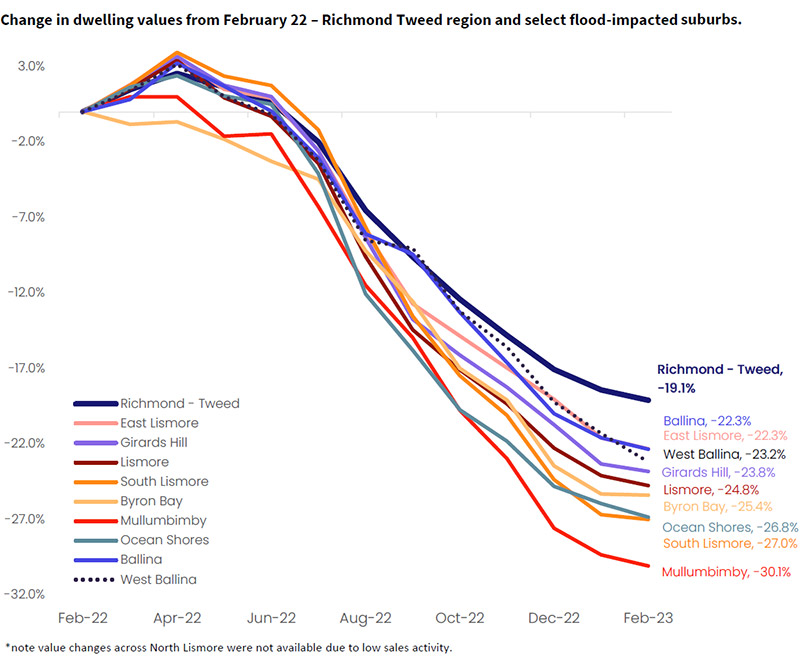
Source: CoreLogic.
And then the rains washed it all away.
In the immediate aftermath of the flood, Richmond-Tweed’s transaction and listing activity fell sharply.
According to CoreLogic, the ensuing three months saw sales activity drop 39.8 per cent compared to the same period the year prior and 23.5 per cent below the previous five-year average, while newly advertised listings fell 18.8 per cent and 14.6 per cent, respectively. The delay in flood-affected properties hitting the market saw values record a residual increase over March and April before recording a sharp decline in May (which also aligned with the first interest rate rise on 3 May).
Mullumbimby recorded the largest 12-month decline nationally, down 30.1 per cent, roughly equivalent to a $432,000 decline in the median value, followed by South Lismore (-27.0 per cent), Ocean Shores (-26.8 per cent) and Byron Bay (-25.4 per cent). The other impacted suburbs saw values fall between 22 per cent and 25 per cent.
Using satellite imagery, CoreLogic tracked the change in the median residential property valuation for flood-impacted properties compared with the change in non-impacted properties between February 2022 and February 2023.
Lismore recorded the largest performance gap, with flood impacted properties recording a 28.6 per cent drop in median values, compared to a fall of 10.9 per cent for non-impacted properties, while Ballina recorded a milder performance gap of two percentage points.
Byron Bay recorded a larger decline in the median value for non-impacted properties, down 24.7 per cent compared to a 23.6 per cent decline for flooded properties. At the suburb level, impacted properties across Byron Bay recorded a 9.1 percentage point sharper decline compared to non-impacted properties, while the gap across East Lismore, Girards Hill, Lismore, Ballina and West Ballina ranged from 20 to 150 basis points. By contrast, Ocean Shores and Mullumbimby had slightly larger declines in unimpacted properties.
Brisbane flood impact on property prices varied
The extreme weather event of 2022 saw the equivalent of the city’s average annual rainfall falling over three days.
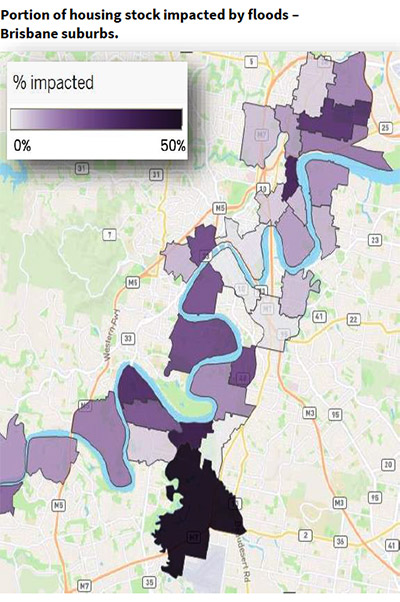
Source: CoreLogic.
Despite recording a smaller peak flood level compared to 2011, the concentration of rainfall across the inner city, as opposed to the river catchment to the west, saw more properties impacted. Across the Brisbane council area, approximately 3.5 per cent of residential housing stock was impacted by flooding, the majority of these located across the Inner city along with the South and West areas.
While some markets were hit particularly hard, the overall impact varied widely between suburbs with predominantly house or unit distribution.
Dwelling value declines across Newstead (-0.7 per cent), Milton (-2.4 per cent), West End (-3.1 per cent) and St Lucia (-3.7 per cent) have been fairly mild despite the floods, likely due to the higher proportion of units across these suburbs, which have remained fairly resilient to a material drop in values compared to houses though the downturn to date. Additionally, the majority of damage sustained by flood-impacted units was likely limited to communal property (car parks, lift wells and foyer entries for example), resulting in a smaller direct impact to homeowners.
By comparison, impacted suburbs with a larger proportion of lower density housing stock, including Chelmer (-11.0 per cent), Rocklea (-13.3 per cent) and more even split suburbs like Ascot (-10.9 per cent) and Yeronga (-14.0 per cent) recorded larger value declines, according to the CoreLogic data.
CoreLogic Economist, Kaytlin Ezzy, said looking forward, the outlook for flood-impacted suburbs across Brisbane and the Northern Rivers remains uncertain.
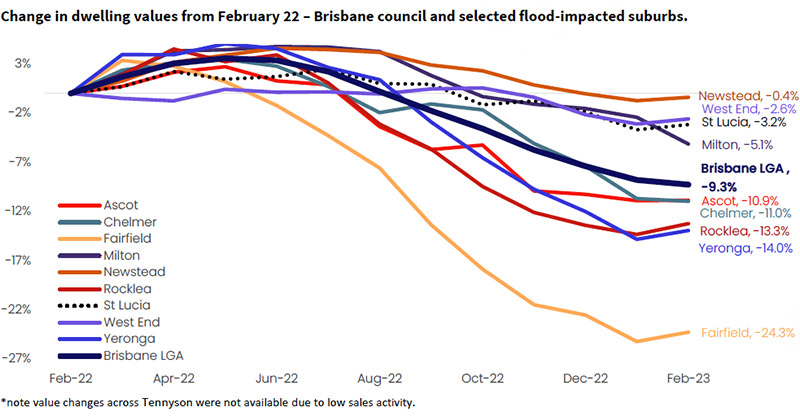
Source: CoreLogic.
“Historically, both markets have been fairly resilient to flood-induced declines.
“Following the 2011 floods, the majority of Brisbane's flood-impacted suburbs saw values recover within three to five years, with most riverside precincts recouping their waterfront premium.
“Directly after the 2017 floods, property values across Lismore remained somewhat flat before returning to the national trend within six months, however, given the severity of this event, and the short timeframe between major flood events, it’s likely the current value declines across the Northern rivers and impacted house suburbs in Brisbane could be more enduring,” Ms Ezzy said.
Covid sent property market soaring
Australian home values initially declined at the onset of the pandemic.
The initial uncertainty around the pandemic, lockdowns, and a sharp decline in economic activity put downward pressure on residential sales and listings volumes, and home values fell 1.9 per cent between April and September of 2020.
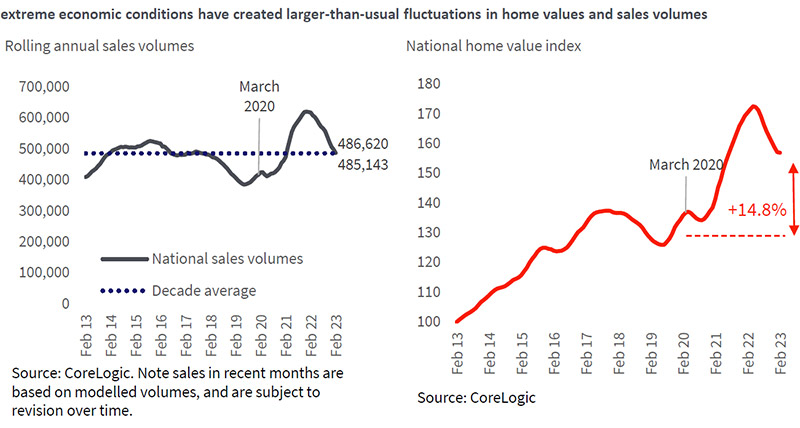
This brief drop in housing values was followed by the sharpest upswing in home values on record.
National dwelling values rose 28.6 per cent from September 2020 to April 2022.
An enormous, three-pronged monetary policy expansion, and stimulus payments of around $120 billion, helped to turn around a sharp decline in economic activity, and shift sentiment in favour of the housing market.
Sales volumes surged, peaking at 619,915 in the 2021 calendar year.
From May 2022, interest rates started on the fastest consecutive uplift on record, and national home values recorded a 9.1 per cent fall through to the end of February (the largest downswing on record).
Annual sales volumes are down 21.5 per cent from a peak in December. Despite the recent volatility, home values remain 14.8 per cent higher overall.
Real estate performance a mixed bag
While CoreLogic’s national Home Value Index (HVI) is still well above pre-COVID levels, results vary by region.
In the three years to the end of February, the Regional South Australia’s HVI increased 47.6 per cent, while values across Melbourne have virtually returned to pre-pandemic levels (which also sees Melbourne home values close to where they were at the peak of the previous cycle, in November 2017).
In the past three years, Adelaide houses have come out on top across the capital cities, sitting 43.7 per cent higher than at the end of March 2020. This is the equivalent of a $211,097 increase on the median house value across the city, which is currently sitting at $694,653.
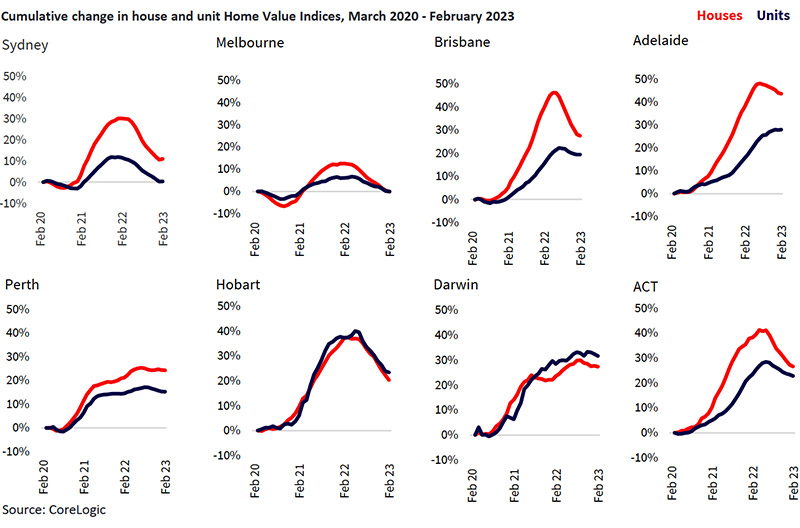
Such dollar value gains are much stronger than the equivalent median house value gain in Sydney (which has risen the equivalent of $119,830), and Melbourne house values have actually seen a decline since March 2020, down the equivalent of $1,009 at the median house value level.
Why have the results been so mixed?
According to Ms Ezzy, high cumulative gains three years on from the pandemic are more common across relatively affordable markets, which be attributable to the fact expensive markets often require more debt to buy into, and therefore may be more sensitive to rate hikes.
“However, there are other factors at play, such as migration trends, and the relative rental return of different markets.
“Western Australia, where gross rent yields were relatively high at 5.0 per cent in February, has seen outperformance in the volume of investment purchases relative to the rest of the country.”
Regional markets still riding high
Regional Australia’s property market surged as people sought refuge from the pandemic, illness, offices and lockdowns.
But despite many of those sea and tree changers returning to the suburban roots, regional property is still relatively well off compared to the cities.
Across the combined regional dwelling market, values remain 30.7 per cent higher than at the onset of COVID-19, compared with values sitting 10.4 per cent higher across the combined capitals.
“While migration flows away from regional Australia may help to ease pressure on demand for some markets, it is clear that regional markets have retained the most value since the onset of the pandemic.
“The normalisation of remote work among certain professionals, which is reinforced by current tight labour market conditions, may be contributing to this lasting value,” Ms Ezzy said.


